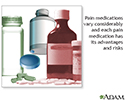Over-the-counter pain relievers
Medicines for pain non-narcotic; Drugs for pain non-narcotic; Analgesics; Acetaminophen; NSAID; Nonsteroidal anti-inflammatory drug; Pain medicine - over-the-counter; Pain medicine - OTC
Over-the-counter (OTC) pain relievers can help relieve pain or lower a fever. Over-the-counter means you can buy these medicines without a prescription.
The most common types of OTC pain medicines are acetaminophen and nonsteroidal anti-inflammatory drugs (NSAIDs).
Information
Pain medicines are also called analgesics. Each kind of pain medicine has benefits and risks. Some types of pain respond better to one kind of medicine than to another kind. What takes away your pain might not work for someone else.
Taking pain medicines before exercising is OK. But do not overdo the exercise just because you have taken the medicine.
Read labels to learn how much medicine you can give your child at one time and during the whole day. This is known as the dosage. Talk to your pharmacist or your child’s health care provider if you are not sure about the correct amount. Do not give children medicine that is meant for adults.
Other tips for taking pain medicines:
- If you take pain relievers on most days, tell your provider. You may need to be watched for side effects.
- Do not take more than the amount recommended on the container or more than your provider tells you to take.
- Read the warnings on the label before taking the medicine.
- Store medicine safely and securely . Check the dates on medicine containers to see when you should throw them away.
ACETAMINOPHEN
Acetaminophen is known as a non-aspirin pain reliever. It is NOT an NSAID, which is described below.
- Acetaminophen relieves fever and headaches, and other common aches and pains. It does not relieve inflammation.
- This medicine does not cause as many stomach problems as other pain medicines do. It is also safer for children. Acetaminophen is often recommended for arthritis pain because it has fewer side effects than other pain medicines.
- Examples of OTC brands of acetaminophen are Tylenol, Paracetamol, and Panadol.
- Acetaminophen prescribed by a doctor is usually a stronger medicine. It is often combined with a narcotic ingredient.
PRECAUTIONS
- Adults should not take more than 3 grams (3,000 mg) of acetaminophen in a single day. Large amounts can harm your liver. Remember that 3 grams is about the same as 6 extra-strength pills or 9 regular pills.
- If you are also taking pain medicine prescribed by your provider, talk to your provider or pharmacist before taking any OTC acetaminophen.
- For children, follow package instructions for the maximum amount your child can have in a single day. Call your child's provider if you are not sure about the instructions.
NSAIDS
- NSAIDs relieve fever and pain. They also reduce swelling from arthritis or a muscle sprain or strain.
- When taken for a short time (no longer than 10 days), NSAIDs are safe for most people.
- Some NSAIDs can be bought over the counter, such as aspirin, ibuprofen (Advil, Motrin), and naproxen (Aleve, Naprosyn).
- Other NSAIDs are prescribed by your provider.
PRECAUTIONS
-
DO NOT give aspirin to children
.
Reye syndrome
can occur when aspirin is used to treat children who have viral infections, such as chickenpox or the flu.
Reye syndrome
Reye syndrome is sudden (acute) brain damage and liver function problems. This condition does not have a known cause. This syndrome has occurred in ...
 ImageRead Article Now Book Mark Article
ImageRead Article Now Book Mark Article
Talk to your provider or pharmacist before using any over-the-counter NSAID if you:
- Have heart disease, high blood pressure, kidney disease, or stomach or digestive tract bleeding.
-
Take other medicines, especially blood thinners such as
warfarin
(Coumadin),
clopidgrel
(Plavix), apixiban (Eliquis), dabigatran (Pradaxa), or rivaroxaban (Xarelto).
Warfarin
Warfarin is a medicine that makes your blood less likely to form clots. This may be important if:You have already had blood clots in your leg, arm, ...
Read Article Now Book Mark ArticleClopidgrel
Blood thinners - clopidogrel; Antiplatelet therapy - clopidogrel; Thienopyridines
 ImageRead Article Now Book Mark Article
ImageRead Article Now Book Mark Article - Are taking NSAIDs prescribed by your provider, including celecoxib (Celebrex) or nabumetone (Relafen).
References
Aronson JK. Non-steroidal anti-inflammatory drugs (NSAIDs). In: Aronson JK, ed. Meyler's Side Effects of Drugs . 16th ed. Waltham, MA: Elsevier; 2016:236-272.
Dinakar P. Principles of pain management. In: Daroff RB, Jankovic J, Mazziotta JC, Pomeroy SL, eds. Bradley's Neurology in Clinical Practice . 7th ed. Philadelphia, PA: Elsevier; 2016:chap 54.
-
Pain medications - illustration
Not all pain medications are alike and each person is slightly different in the way they respond to a pain medication. Specific types and causes of pain may respond better to one kind of pain medication than to another kind.
Pain medications
illustration
-
Back pain and sciatica
(In-Depth)
-
Fibromyalgia
(In-Depth)
Review Date: 12/10/2016
Reviewed By: Linda J. Vorvick, MD, Clinical Associate Professor, Department of Family Medicine, UW Medicine, School of Medicine, University of Washington, Seattle, WA. Also reviewed by David Zieve, MD, MHA, Medical Director, Brenda Conaway, Editorial Director, and the A.D.A.M. Editorial team.

